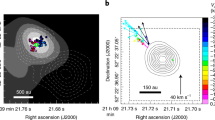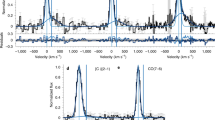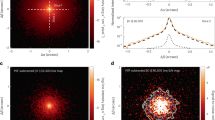Abstract
Radially extended disk winds could be the key to unlocking how protoplanetary disks accrete and how planets form and migrate. A distinctive characteristic is their nested morphology of velocity and chemistry. Here we report James Webb Space Telescope near-infrared spectrograph spectro-imaging of four young stars with edge-on disks, three of which have already dispersed their natal envelopes. For each source, a fast collimated jet traced by [Fe ii] is nested inside a hollow cavity within wider lower-velocity H2. In one case, a hollow structure is also seen in CO ro-vibrational (v = 1 → 0) emission but with a wider opening angle than the H2, and both of those are nested inside an Atacama Large Millimeter Array CO (J = 2 → 1) cone with an even wider opening angle. This nested morphology, even for sources with no envelope, strongly supports theoretical predictions for wind-driven accretion and underscores the need for theoretical work to assess the role of winds in the formation and evolution of planetary systems.
This is a preview of subscription content, access via your institution
Access options
Access Nature and 54 other Nature Portfolio journals
Get Nature+, our best-value online-access subscription
27,99 € / 30 days
cancel any time
Subscribe to this journal
Receive 12 digital issues and online access to articles
118,99 € per year
only 9,92 € per issue
Buy this article
- Purchase on SpringerLink
- Instant access to full article PDF
Prices may be subject to local taxes which are calculated during checkout




Similar content being viewed by others
Data availability
The JWST data used in this paper can be found at the Mikulski Archive for Space Telescope under programme IDs 1621 (ref. 56) and 1128 (ref. 57). The first programme covers the four edge-on disks, and the second has the commissioning data used to generate the NIRSpec PSF. Both raw data and fully processed pipeline data can be downloaded from the archive. The spectra integrated over the NIRSpec IFU (Fig. 1) as well as the line-only and continuum maps (Fig. 2) are available via Figshare at https://doi.org/10.6084/m9.figshare.26387977 (ref. 58).
Code availability
The data were reduced with the JWST calibration pipeline v.1.13.4.dev19+gbddb39c6. Upon request, the first author (I.P.) will provide the Python scripts used to analyse the data and generate the figures.
References
Balbus, S. A. & Hawley, J. F. A powerful local shear instability in weakly magnetized disks. I. Linear analysis. Astrophys. J. 376, 214 (1991).
Lesur, G. et al. in Protostars and Planets VII (eds Inutsuka, S. et al.) 465–500 (ASP, 2023).
Suzuki, T. K., Ogihara, M., Morbidelli, A., Crida, A. & Guillot, T. Evolution of protoplanetary discs with magnetically driven disc winds. Astron. Astrophys. 596, A74 (2016).
Taki, T., Kuwabara, K., Kobayashi, H. & Suzuki, T. K. New growth mechanism of dust grains in protoplanetary disks with magnetically driven disk winds. Astrophys. J. 909, 75 (2021).
Kimmig, C. N., Dullemond, C. P. & Kley, W. Effect of wind-driven accretion on planetary migration. Astron. Astrophys. 633, A4 (2020).
Wang, L., Bai, X.-N. & Goodman, J. Global simulations of protoplanetary disk outflows with coupled non-ideal magnetohydrodynamics and consistent thermochemistry. Astrophys. J. 874, 90 (2019).
Shu, F. et al. Magnetocentrifugally driven flows from young stars and disks. I. A generalized model. Astrophys. J. 429, 781 (1994).
Alexander, R., Pascucci, I., Andrews, S., Armitage, P. & Cieza, L. in Protostars and Planets VI (eds Beuther, H. et al.) 475–496 (ASP, 2014).
Panoglou, D. et al. Molecule survival in magnetized protostellar disk winds. I. Chemical model and first results. Astron. Astrophys. 538, A2 (2012).
Shu, F. H., Najita, J., Ostriker, E. C. & Shang, H. Magnetocentrifugally driven flows from young stars and disks. V. Asymptotic collimation into jets. Astrophys. J. Lett. 455, L155 (1995).
Matsuyama, I., Johnstone, D. & Hollenbach, D. Dispersal of protoplanetary disks by central wind stripping. Astrophys. J. 700, 10–19 (2009).
Cunningham, A., Frank, A. & Hartmann, L. Wide-angle wind-driven bipolar outflows: high-resolution models with application to source I of the Becklin-Neugebauer/Kleinmann-low OMC-I region. Astrophys. J. 631, 1010–1021 (2005).
Wang, L. & Goodman, J. Hydrodynamic photoevaporation of protoplanetary disks with consistent thermochemistry. Astrophys. J. 847, 11 (2017).
Evans II, N. J. et al. The Spitzer c2d legacy results: star-formation rates and efficiencies; evolution and lifetimes. Astrophys. J. Suppl. Ser. 181, 321–350 (2009).
Gangi, M. et al. GIARPS high-resolution observations of T Tauri stars (GHOsT). II. Connecting atomic and molecular winds in protoplanetary disks. Astron. Astrophys. 643, A32 (2020).
Pascucci, I. et al. in Protostars and Planets VII (eds Inutsuka, S. et al.) 567 (ASP, 2023).
Agra-Amboage, V. et al. Origin of the wide-angle hot H2 in DG Tauri. New insight from SINFONI spectro-imaging. Astron. Astrophys. 564, A11 (2014).
Beck, T. L. & Bary, J. S. A search for spatially resolved infrared rovibrational molecular hydrogen emission from the disks of young stars. Astrophys. J. 884, 159 (2019).
Arulanantham, N. et al. JWST MIRI MRS images of disk winds, water, and CO in an edge-on protoplanetary disk. Astrophys. J. Lett. 965, L13 (2024).
Böker, T. et al. In-orbit performance of the near-infrared spectrograph NIRSpec on the James Webb Space Telescope. Publ. Astron. Soc. Pac. 135, 038001 (2023).
Villenave, M. et al. Observations of edge-on protoplanetary disks with ALMA. I. Results from continuum data. Astron. Astrophys. 642, A164 (2020).
Luhman, K. L. The stellar membership of the Taurus star-forming region. Astron. J. 156, 271 (2018).
Furlan, E. et al. The Spitzer infrared spectrograph survey of T Tauri stars in Taurus. Astrophys. J. Suppl. Ser. 195, 3 (2011).
Crapsi, A., van Dishoeck, E. F., Hogerheijde, M. R., Pontoppidan, K. M. & Dullemond, C. P. Characterizing the nature of embedded young stellar objects through silicate, ice and millimeter observations. Astron. Astrophys. 486, 245–254 (2008).
Di Francesco, J., Johnstone, D., Kirk, H., MacKenzie, T. & Ledwosinska, E. The SCUBA legacy catalogues: submillimeter-continuum objects detected by SCUBA. Astrophys. J. Suppl. Ser. 175, 277–295 (2008).
Reipurth, B., Chini, R., Krugel, E., Kreysa, E. & Sievers, A. Cold dust around Herbig-Haro energy sources – a 1300-micron survey. Astron. Astrophys. 273, 221–238 (1993).
Andrews, S. M. & Williams, J. P. Circumstellar dust disks in Taurus-Auriga: the submillimeter perspective. Astrophys. J. 631, 1134–1160 (2005).
Andrews, S. M., Rosenfeld, K. A., Kraus, A. L. & Wilner, D. J. The mass dependence between protoplanetary disks and their stellar hosts. Astrophys. J. 771, 129 (2013).
Takami, M. et al. Subaru IR echelle spectroscopy of Herbig-Haro driving sources. I. H2 and [Fe ii] emission. Astrophys. J. 641, 357–372 (2006).
Bacciotti, F., Eislöffel, J. & Ray, T. P. The physical properties of the HH 30 jet from HST and ground-based data. Astron. Astrophys. 350, 917–927 (1999).
Nisini, B. et al. Connection between jets, winds and accretion in T Tauri stars. The X-shooter view. Astron. Astrophys. 609, A87 (2018).
White, R. J. & Hillenbrand, L. A. On the evolutionary status of class I stars and Herbig-Haro energy sources in Taurus-Auriga. Astrophys. J. 616, 998–1032 (2004).
Davis, C. J. et al. VLT integral field spectroscopy of embedded protostars: using near-infrared emission lines as tracers of accretion and outflow. Astron. Astrophys. 528, A3 (2011).
Nisini, B. et al. PROJECT-J: JWST observations of HH46 IRS and its outflow. Overview and first results. Astrophys. J. 967, 168 (2024).
Jensen, S. K. et al. Spectroastrometric survey of protoplanetary disks with inner dust cavities. Astron. J. 167, 115 (2024).
Eislöffel, J. & Mundt, R. Imaging and kinematic studies of young stellar object jets in Taurus. Astron. J. 115, 1554–1575 (1998).
Hartigan, P. & Morse, J. Collimation, proper motions, and physical conditions in the HH 30 jet from Hubble Space Telescope slitless spectroscopy. Astrophys. J. 660, 426–440 (2007).
Louvet, F. et al. The HH30 edge-on T Tauri star. A rotating and precessing monopolar outflow scrutinized by ALMA. Astron. Astrophys. 618, A120 (2018).
Erkal, J. et al. Launching the asymmetric bipolar jet of DO Tau. Astron. Astrophys. 650, A46 (2021).
Blandford, R. D. & Payne, D. G. Hydromagnetic flows from accretion disks and the production of radio jets. Mon. Not. R. Astron. Soc. 199, 883–903 (1982).
Ai, T.-H., Liu, C.-F., Shang, H., Johnstone, D. & Krasnopolsky, R. A unified model for bipolar outflows from young stars: kinematic and mixing structures in HH 30. Astrophys. J. 964, 147 (2024).
Rabenanahary, M., Cabrit, S., Meliani, Z. & Pineau des Forêts, G. Wide-angle protostellar outflows driven by narrow jets in stratified cores. Astron. Astrophys. 664, A118 (2022).
Liang, L., Johnstone, D., Cabrit, S. & Kristensen, L. E. Steady wind-blown cavities within infalling rotating envelopes: application to the broad velocity component in young protostars. Astrophys. J. 900, 15 (2020).
Komaki, A., Nakatani, R. & Yoshida, N. Radiation hydrodynamics simulations of protoplanetary disks: stellar mass dependence of the disk photoevaporation rate. Astrophys. J. 910, 51 (2021).
Rab, C. et al. Interpreting molecular hydrogen and atomic oxygen line emission of T Tauri disks with photoevaporative disk-wind models. Astron. Astrophys. 668, A154 (2022).
Béthune, W., Lesur, G. & Ferreira, J. Global simulations of protoplanetary disks with net magnetic flux. I. Non-ideal MHD case. Astron. Astrophys. 600, A75 (2017).
Giacalone, S., Teitler, S., Königl, A., Krijt, S. & Ciesla, F. J. Dust transport and processing in centrifugally driven protoplanetary disk winds. Astrophys. J. 882, 33 (2019).
Bushouse, H. et al. JWST Calibration Pipeline (STScI, 2023).
Richardson, W. H. Bayesian-based iterative method of image restoration. J. Opt. Soc. Am. 62, 55 (1972).
Lucy, L. B. An iterative technique for the rectification of observed distributions. Astron. J. 79, 745 (1974).
Perrin, M. D. et al. Updated point spread function simulations for JWST with WebbPSF. In Proc. SPIE Conference Series, Space Telescopes and Instrumentation 2014: Optical, Infrared, and Millimeter Wave Vol. 9143 (eds Oschmann, J. M. Jr et al.) 91433X (SPIE, 2014).
Beck, T. L., McGregor, P. J., Takami, M. & Pyo, T.-S. Spatially resolved molecular hydrogen emission in the inner 200 au environments of classical T Tauri stars. Astrophys. J. 676, 472–489 (2008).
Gordon, I. E. et al. The HITRAN2020 molecular spectroscopic database. J. Quant. Spectrosc. Radiat. Transf. 277, 107949 (2022).
Mundt, R., Ray, T. P. & Raga, A. C. Collimation of stellar objects – constraints from the observed spatial structure. II. Observational results. Astron. Astrophys. 252, 740–761 (1991).
Habel, N. M. et al. An HST survey of protostellar outflow cavities: does feedback clear envelopes? Astrophys. J. 911, 153 (2021).
Pascucci, I. Data from paper ‘The nested morphology of disk winds from young stars revealed by JWST/NIRSpec observations’. Mikulski Archive for Space Telescopes https://doi.org/10.17909/3z83-wx27 (2024).
Pascucci, I. Commissioning data used in ‘The nested morphology of disk winds from young stars revealed by JWST/NIRSpec observations’. Mikulski Archive for Space Telescopes https://doi.org/10.17909/325d-tm53 (2024).
Pascucci, I. et al. The nested morphology of disk winds from young stars revealed by JWST/NIRSpec observations. Figshare https://doi.org/10.6084/m9.figshare.26387977 (2024).
Simon, M. et al. Masses and implications for ages of low-mass pre-main-sequence stars in Taurus and Ophiuchus. Astrophys. J. 884, 42 (2019).
Duchêne, G. et al. JWST imaging of edge-on protoplanetary disks. I. Fully vertically mixed 10 μm grains in the outer regions of a 1000 au disk. Astron. J. 167, 77 (2024).
Acknowledgements
This work is based on observations made with the NASA/ESA/CSA JWST. The data were obtained from the Mikulski Archive for Space Telescopes at the Space Telescope Science Institute, which is operated by the Association of Universities for Research in Astronomy, Inc., under NASA contract NAS 5-03127 for JWST. These observations are associated with the general observer cycle 1 programme 1621 (PI I. Pascucci). I.P. and N.S.B. acknowledge partial support from NASA and the Space Telescope Science Institute (GO Grant No. JWST-GO-01621.001, PI I.P.). S.C. acknowledges funding from the funding from the Scientific Council of Observatoire de Paris and the national programme Physique et Chimie du Milieu Interstellaire of Centre National de la Recherche Scientifique, a programme operated through the Institut National des Sciences de l'Univers with Institut National de Chimie and Institut National de Physique and co-funded by the Commissariat à l'Energie Atomique et aux Energies Alternatives and Centre National d'Etudes Spatiales. K.S. and D.S. acknowledge support from the European Research Council (ERC) under the Horizon 2020 Framework Program through ERC Advanced Grant Origins 83 24 28, PI Th. Henning. G.D. acknowledges support from the ERC under the European Union’s Horizon Europe research and innovation programme (Grant Agreement No. 101053020, Project Dust2Planets, PI F. Ménard). M.V. acknowledges support from the ERC under the European Union’s Horizon Europe Research & Innovation Programme (Grant Agreement No. 101039651, DiscEvol, PI G. Rosotti). I.P. thanks D. Deng and F. Long for an initial exploration of the ALMA data for our sources. We acknowledge the use of the following packages: api, Astropy, NumPy, SciPy, sklearn, Matplotlib and pandas.
Author information
Authors and Affiliations
Contributions
I.P. led the proposal, carried out the analysis and wrote the paper. T.B., S.C., S.E., J.N., U.G., C.S., S.B., S.K., J.M., M.R., K.S. and D.S. contributed to the planning and writing of the JWST proposal. N.S.B. used the JWST pipeline to perform the data reduction. T.B. assisted in planning the observations, in the data reduction and in the PSF deconvolution of the reduced data cubes. F.L. provided the ALMA CO (2 → 1) data for HH 30. B.S. contributed to the initial script used to generate the CO (v = 1 → 0) map and the RGB figures. S.C., S.E., J.N. and U.G. made substantial contributions to the interpretation of the results. All authors participated in the discussion of the results or commented on the paper.
Corresponding author
Ethics declarations
Competing interests
The authors declare no competing interests.
Peer review
Peer review information
Nature Astronomy thanks Manuele Gangi and the other, anonymous, reviewer(s) for their contribution to the peer review of this work.
Additional information
Publisher’s note Springer Nature remains neutral with regard to jurisdictional claims in published maps and institutional affiliations.
Supplementary information
Supplementary Information
Supplementary Table 1 and Fig. 1.
Rights and permissions
Springer Nature or its licensor (e.g. a society or other partner) holds exclusive rights to this article under a publishing agreement with the author(s) or other rightsholder(s); author self-archiving of the accepted manuscript version of this article is solely governed by the terms of such publishing agreement and applicable law.
About this article
Cite this article
Pascucci, I., Beck, T.L., Cabrit, S. et al. The nested morphology of disk winds from young stars revealed by JWST/NIRSpec observations. Nat Astron 9, 81–89 (2025). https://doi.org/10.1038/s41550-024-02385-7
Received:
Accepted:
Published:
Issue Date:
DOI: https://doi.org/10.1038/s41550-024-02385-7



